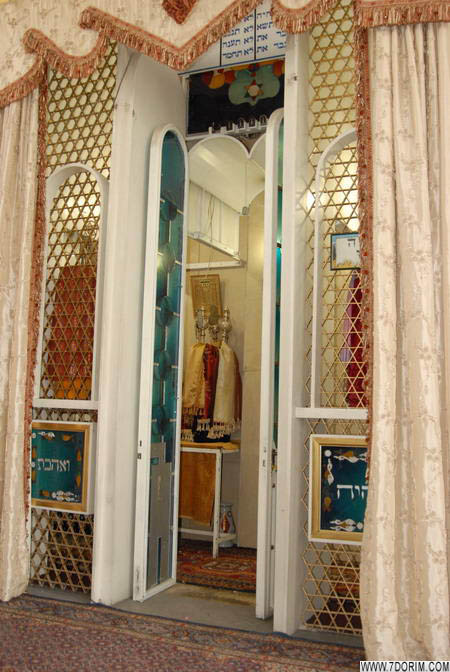One of the important synagogues in Tehran is in the northeastern side of the city. Known as Bagh Saba Synagogue, it is a part of a larger complex including a library, hall, another small synagogue in the first floor, a restaurant, and a school. The interior and exterior design of both synagogues draws inspiration from modern design and the main building. Both synagogues, especially the smaller one, have been designed and furnished to imitate a synagogue – this includes seating, altar, and Torah ark.
The synagogue, built in the 1950s, was made possible by a group of philanthropists, backed by the residents of Bagh Saba and the surrounding areas along Old Shemiran Road. The initiative to establish a synagogue was spearheaded by Suleiman Razeghi, who devoted one of his rooms to this purpose and housed a Torah scroll there.
With the support of his family, Salim Kerendian donated their two-story house to be transformed into a synagogue. This transformed the synagogue from a single room into a two-story building. Additionally, the Kerendian family covered all synagogue expenses, including water, electricity, and telephone bills, as well as repair costs. They also ensured the synagogue’s account remained full through their continuous generous donations.
As Jewish migration to the neighborhood increased, the synagogue’s council recognized the pressing need for cultural institutions, a school, and a larger, well-equipped synagogue. The congregation had grown to a point where the existing space could no longer accommodate the rising population, particularly during important holidays like Rosh Hashanah and Yom Kippur, despite efforts to expand the capacity by covering the yard.
After several meetings, the synagogue council decided to construct a cultural complex with the help of community philanthropists that included a large synagogue and a school for children in the Bagh Saba neighborhood. A plot belonging to Suleiman Razeghi happened to be next to the synagogue, on which Salim Kerendian had built a stone-crushing factory called the Foroughi Factory. By order of the government, all industrial centers had been transferred outside of Tehran, and Salim Kerendian’s factory had also been transferred to Shah Abdul Azim Road.
Synagogue members visited the late Nurullah Hai and Mozafar Mosanen to discuss their needs for the new complex. The two individuals generously donated 100,000 and 30,000 rials, respectively, providing enough funds for the required deposit to purchase the plot. Furthermore, Suleiman Razaghi played a crucial role in facilitating the purchase, asking for a price below market value.
As help arrived from community philanthropist, especially Ashmon Neman and his sons, a luxurious building with a floor area of 1,995 square meters was built in two floors. The second floor had a synagogue with a capacity of 300 people, and the first floor had a synagogue with a capacity of 150 people. The building also included a school with six elementary school classrooms, a hall for ceremonies and gatherings, and a restaurant. The building was constructed under the supervision of engineers Maccabi and Shoushani.
It is worth mentioning that Salim Kurandian provided all the marble stones used in the synagogue, especially for the construction of the bema, free of charge. He also paid the water and electricity bills for many years as a gift to the Bagh Saba Cultural Complex.

Bagh Saba Synagogue
Spring 2009

Bagh Saba Synagogue

Bagh Saba Synagogue
Hekhal door

Bagh Saba Synagogue
The northern side of your journey

Bagh Saba Synagogue

Bagh Saba Synagogue
The northwest side of the (big) Bagh Saba Synagogue

Bagh Saba Synagogue(small)

Bagh Saba Synagogue

Bagh Saba Synagogue
The west side of the (small) Bagh Saba Synagogue

Bagh Saba Synagogue
Please click to see 360-degree images (panorama).
Please click to see 360-degree images (panorama).
Please click to see 360-degree images (panorama) of the small synagogue


 فارسی
فارسی